Top 12 AI Tools for Product Managers in 2025
Discover the best AI tools for product managers in 2025. Boost productivity and make smarter decisions with our expert picks. Click to learn more!

Product managers are drowning in data yet starved for insight. Between endless user feedback, competing stakeholder demands, and a constant pressure to innovate, the real challenge isn't a lack of information-it's the overwhelming noise. While the buzz around artificial intelligence promises a solution, it also adds another layer of complexity. How do you separate genuine, value-adding technology from marketing hype?
This guide cuts through that noise. We've curated a list of 12 practical AI tools for product managers designed to solve specific, daily challenges. Forget generic feature lists; this is about tangible application. We'll explore how these platforms can automatically analyze thousands of customer support tickets, generate user story drafts from raw notes, and identify emerging trends in qualitative feedback before they become critical issues. You will learn how to transform your workflow from reactive fire-fighting to proactive, data-informed strategy.
Each tool profiled includes a detailed breakdown of its core AI capabilities, specific use-case scenarios, and honest limitations. You'll find direct links and screenshots to see the software in action, helping you make a well-informed decision for your team's unique needs. This is your definitive resource for finding the right AI tools for product managers that help you build better products, faster.
1. SigOS
Best for Quantifying the Revenue Impact of Customer Feedback
SigOS distinguishes itself as a premier AI tool for product managers by moving beyond simple feedback aggregation to deliver quantifiable, revenue-centric insights. This platform excels at continuously analyzing qualitative and quantitative data from disparate sources like support tickets, sales calls, and usage metrics. It then uses advanced AI to correlate specific customer issues and feature requests directly to churn risk and expansion opportunities, assigning a real dollar value to each item.
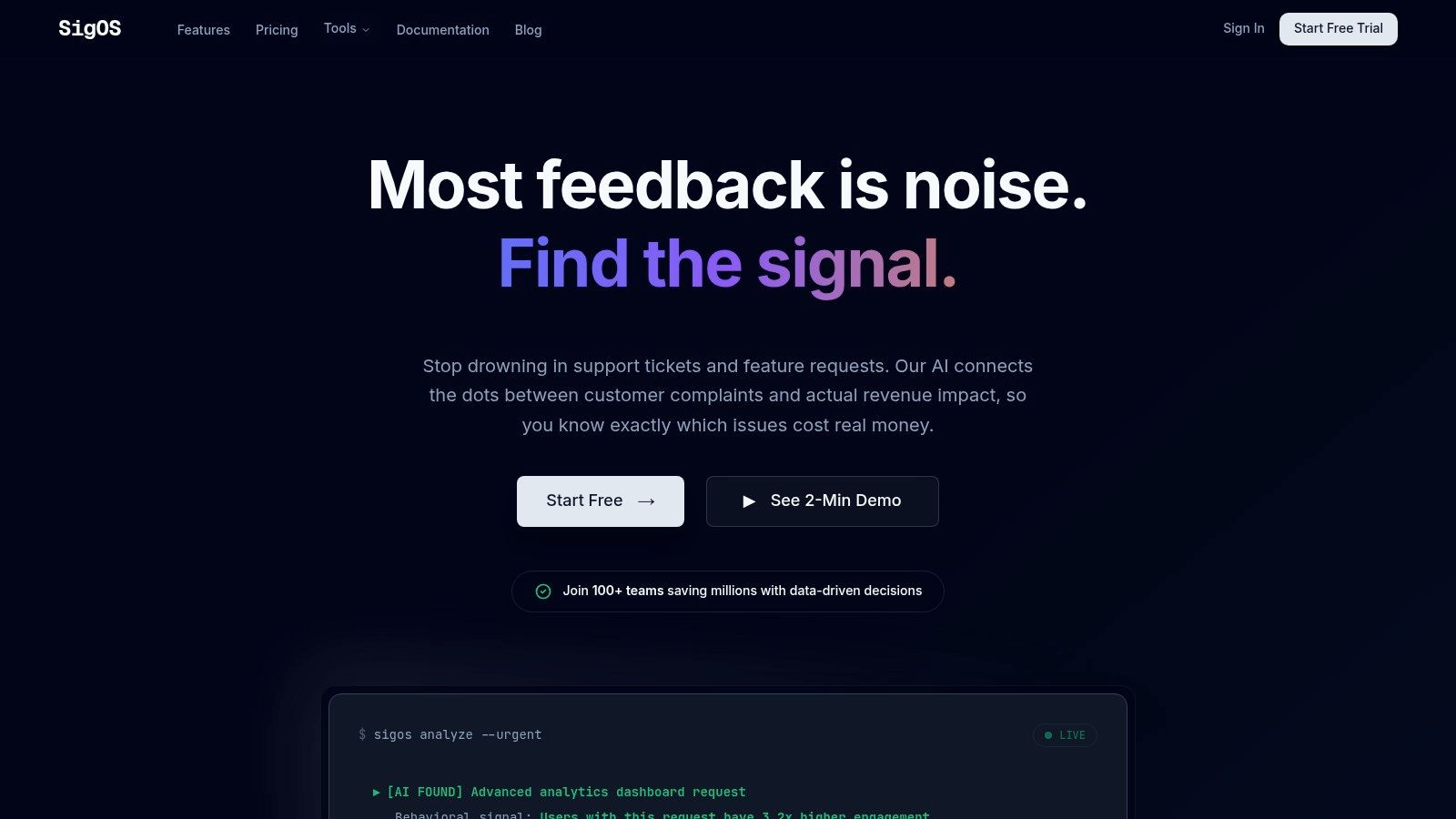
For product managers, this means no more guesswork in prioritization. Instead of a backlog filled with ambiguous requests, you receive a daily dashboard highlighting the exact bugs costing you revenue and the features poised to unlock high-value deals. This data-driven clarity empowers PMs to build roadmaps that are directly aligned with business growth, making it one of the most powerful ai tools for product managers focused on strategic impact.
Key Features & Use Cases
- Revenue-Impact Scoring: Automatically analyzes feedback from Zendesk, Intercom, and sales calls to score bugs and feature requests based on their direct financial impact. This is ideal for justifying resource allocation to engineering and leadership.
- Automated Workflow Integration: Seamlessly creates and prioritizes tickets in Jira, Linear, and GitHub, complete with revenue data. This streamlines the product development lifecycle, ensuring engineering teams are always working on the most critical tasks.
- Real-Time Churn & Expansion Alerts: Proactively notifies teams about emerging patterns that signal churn risk or significant upsell opportunities. Customer success and sales teams can use these alerts to intervene effectively.
Pricing & Implementation
SigOS offers custom pricing based on data volume and the number of integrations. Implementation is streamlined, but teams should allocate time for initial setup and an adjustment period to fully leverage the advanced AI capabilities.
- Pros: Delivers precise, dollar-value insights; automates workflows; provides real-time alerts for proactive management.
- Cons: Primarily focused on SaaS companies; may have a learning curve for non-technical users.
Website: https://sigos.io
2. Productboard
Productboard is an end-to-end product management platform built with a product manager's workflow in mind, from capturing customer feedback to building strategic roadmaps. Its recent integration of AI elevates this process, making it one of the most comprehensive AI tools for product managers looking to consolidate their stack. The platform excels at centralizing customer insights from various channels like Intercom, Zendesk, and Slack.
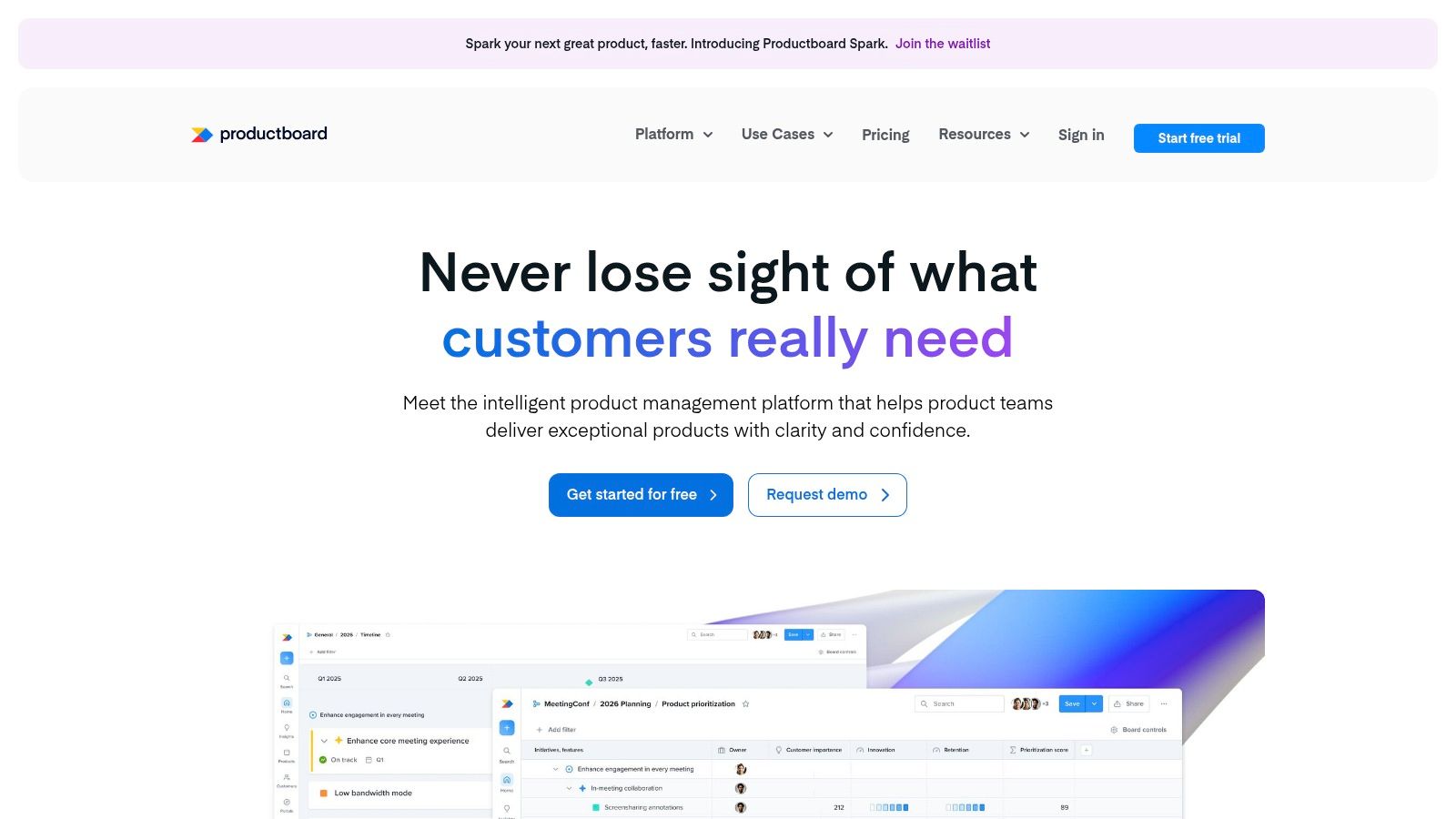
The AI features are designed to reduce manual work significantly. For instance, the AI can summarize lengthy customer feedback notes, automatically extracting key pain points and requests. It can also help draft initial feature specifications and user stories, providing a solid starting point for development tickets. This allows PMs to focus more on strategy and less on administrative tasks.
Core Features & Use Cases
- AI-Powered Summarization: Automatically condenses thousands of customer feedback notes into actionable, thematic insights, saving hours of manual analysis.
- Specification Drafting: Generate first-draft product specs, acceptance criteria, and user stories based on a feature idea, accelerating the handoff to engineering.
- Unified PM Workflow: Its greatest strength is connecting insights directly to feature prioritization and roadmapping, ensuring decisions are data-driven.
Pricing and Access
Productboard offers a tiered pricing model, including a free "Starter" plan for individuals. The more advanced AI capabilities and integrations are typically reserved for the "Scale" and "Enterprise" plans. It's important to verify the specific AI features included in each tier, as the packaging can change.
- Pros: PM-centric design, excellent feedback consolidation, scales from free to enterprise.
- Cons: Key AI features are in higher-cost plans; can be complex to set up initially.
Website: https://www.productboard.com
3. Jira Product Discovery (Atlassian)
Jira Product Discovery is a dedicated space for ideation and prioritization built directly into the Atlassian ecosystem. For teams already invested in Jira for development, it offers a seamless bridge between discovery and delivery. Its unique value lies in connecting upstream strategic thinking with downstream execution, and its AI features are designed to enhance this connection, making it one of the most integrated AI tools for product managers available.
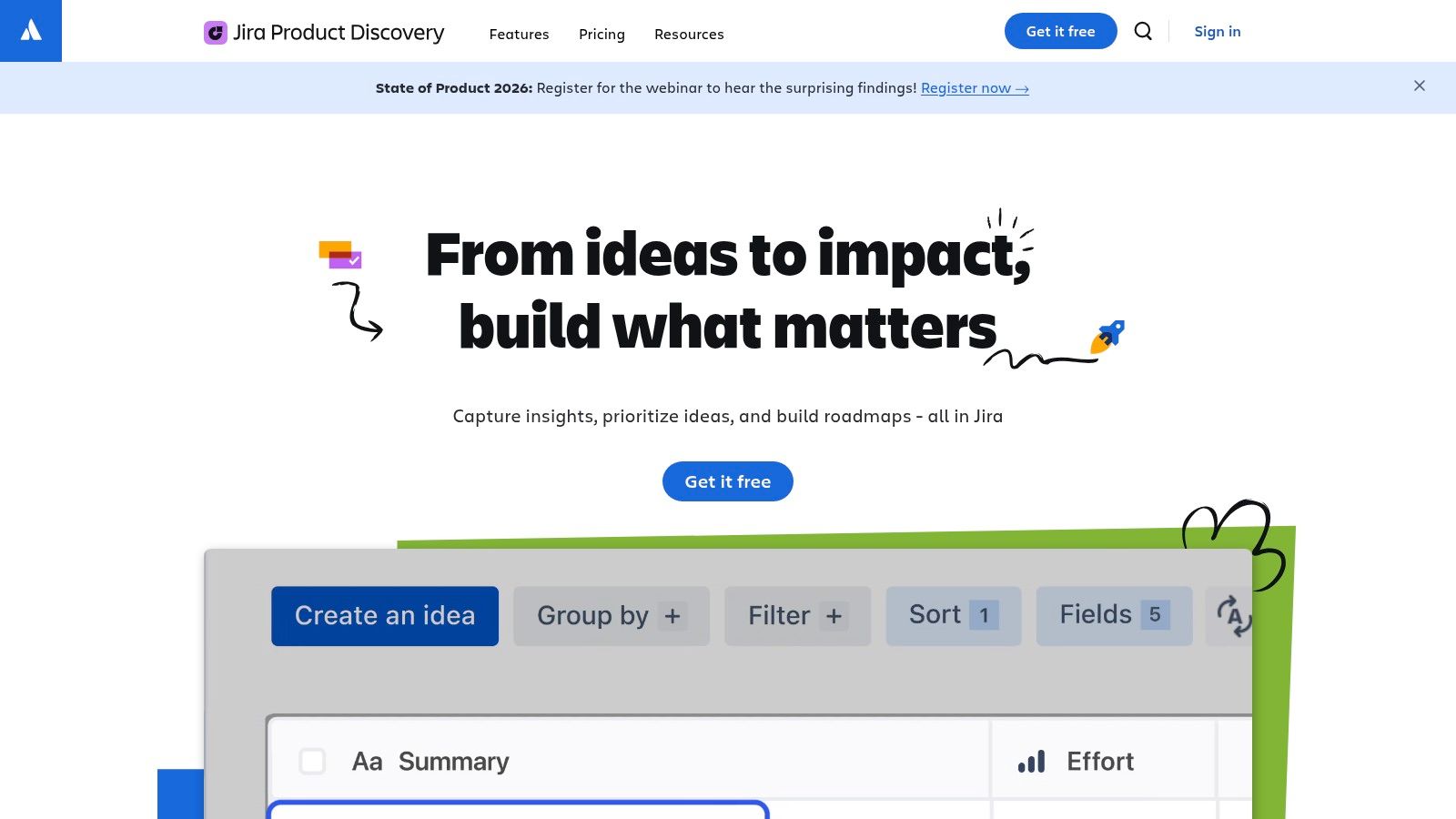
The AI Assist functionality is particularly useful during the early stages of product discovery. It can help teams brainstorm ideas from a blank slate, summarize long comment threads from stakeholders into concise takeaways, and generate user stories or acceptance criteria from a simple idea title. This native integration ensures that valuable context generated during discovery is not lost when an idea moves into the development backlog. Different product management strategies can be easily tested and validated within this unified environment.
Core Features & Use Cases
- AI-Powered Brainstorming & Summarization: Use AI to generate new ideas, summarize insights from stakeholder feedback, and automatically draft idea descriptions, saving time on manual synthesis.
- Seamless Jira Integration: Its biggest advantage is the native connection to Jira Software, allowing PMs to link ideas directly to epics and issues for a smooth handoff to engineering.
- Structured Idea Prioritization: Utilize customizable fields and views to score and rank ideas based on strategic drivers like impact and effort, all within a familiar Jira-like interface.
Pricing and Access
Jira Product Discovery has a free plan that supports up to 3 creators. The AI features, however, are part of the Premium plan, which is priced per creator. The "Contributor" role is free and unlimited, allowing broad participation from stakeholders across the organization without additional cost.
- Pros: Unbeatable integration with the Jira ecosystem, familiar UI for existing Jira users, smooth discovery-to-delivery workflow.
- Cons: Key AI features require a Premium subscription; billing and admin can be complex for users new to the Atlassian suite.
Website: https://www.atlassian.com/software/jira/product-discovery
4. Aha! Roadmaps
Aha! Roadmaps is a comprehensive product development suite designed to connect high-level strategy with detailed execution. Known for its robust roadmapping and planning capabilities, Aha! has integrated an AI assistant across its platform to streamline workflows. This makes it a powerful contender among AI tools for product managers who need to manage complex products and portfolios, especially in larger organizations. The AI helps draft documents, summarize research, and refine user stories directly within the tool.
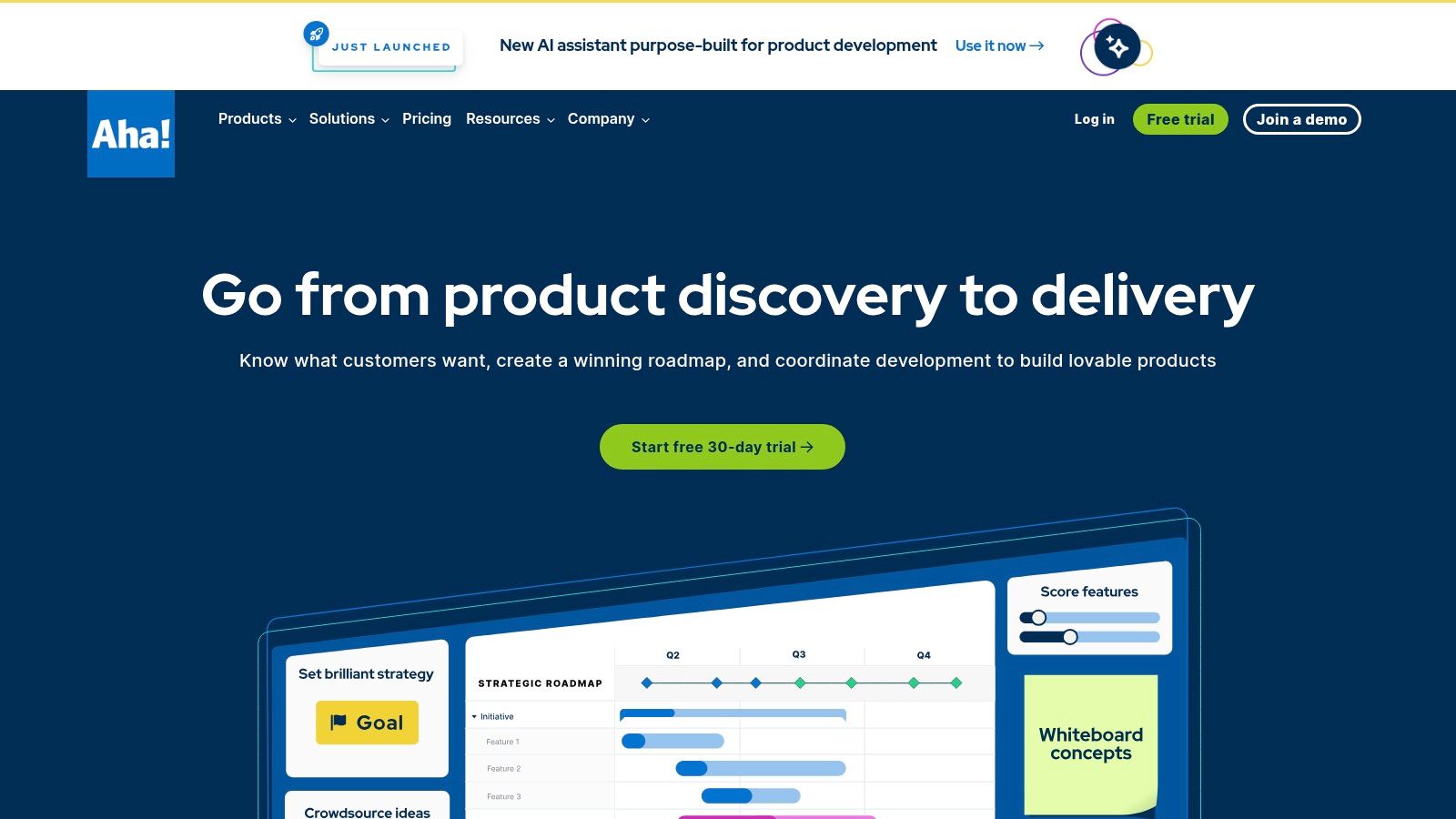
What sets Aha! apart is its modular structure, allowing teams to add on specific capabilities like Ideas, Whiteboards, and Knowledge as needed. The AI assistant is woven throughout these modules, offering contextual support whether you are synthesizing customer feedback from an ideas portal or drafting a new knowledge base article. This integrated approach ensures that AI enhances, rather than disrupts, the established product management process. For organizations managing multiple product lines, Aha! provides strong governance and portfolio-level views. Learn more about the challenges of product portfolio management and how tools can help.
Core Features & Use Cases
- AI-Assisted Document Drafting: Generate first drafts of strategic documents, feature requirements, and user stories, significantly reducing initial writing time.
- Intelligent Summarization: Condense long research notes, customer feedback threads, and competitor analysis into concise, actionable summaries within the platform.
- Modular and Extensible: The platform’s strength lies in its ecosystem of add-ons, allowing companies to build a customized product management environment.
Pricing and Access
Aha! Roadmaps operates on a per-user pricing model with different tiers. The core "Premium" plan includes roadmapping and planning features, while the AI capabilities are part of an "Aha! AI" add-on that comes with an additional cost per user. Other modules like Ideas and Develop are also priced separately, allowing for a tailored but potentially costly setup.
- Pros: Feature-rich for enterprise needs, clear modular structure, strong governance capabilities.
- Cons: Higher price point compared to lighter PM tools; can be overwhelming for small teams.
Website: https://www.aha.io
5. Notion (with Notion AI)
Notion has evolved from a versatile documentation tool into a powerful all-in-one workspace, and the addition of Notion AI solidifies its place among essential AI tools for product managers. It excels at centralizing product requirement documents (PRDs), user research, meeting notes, and team knowledge bases. The platform's flexibility allows PMs to build custom databases for backlogs and lightweight roadmaps, all within a single environment.
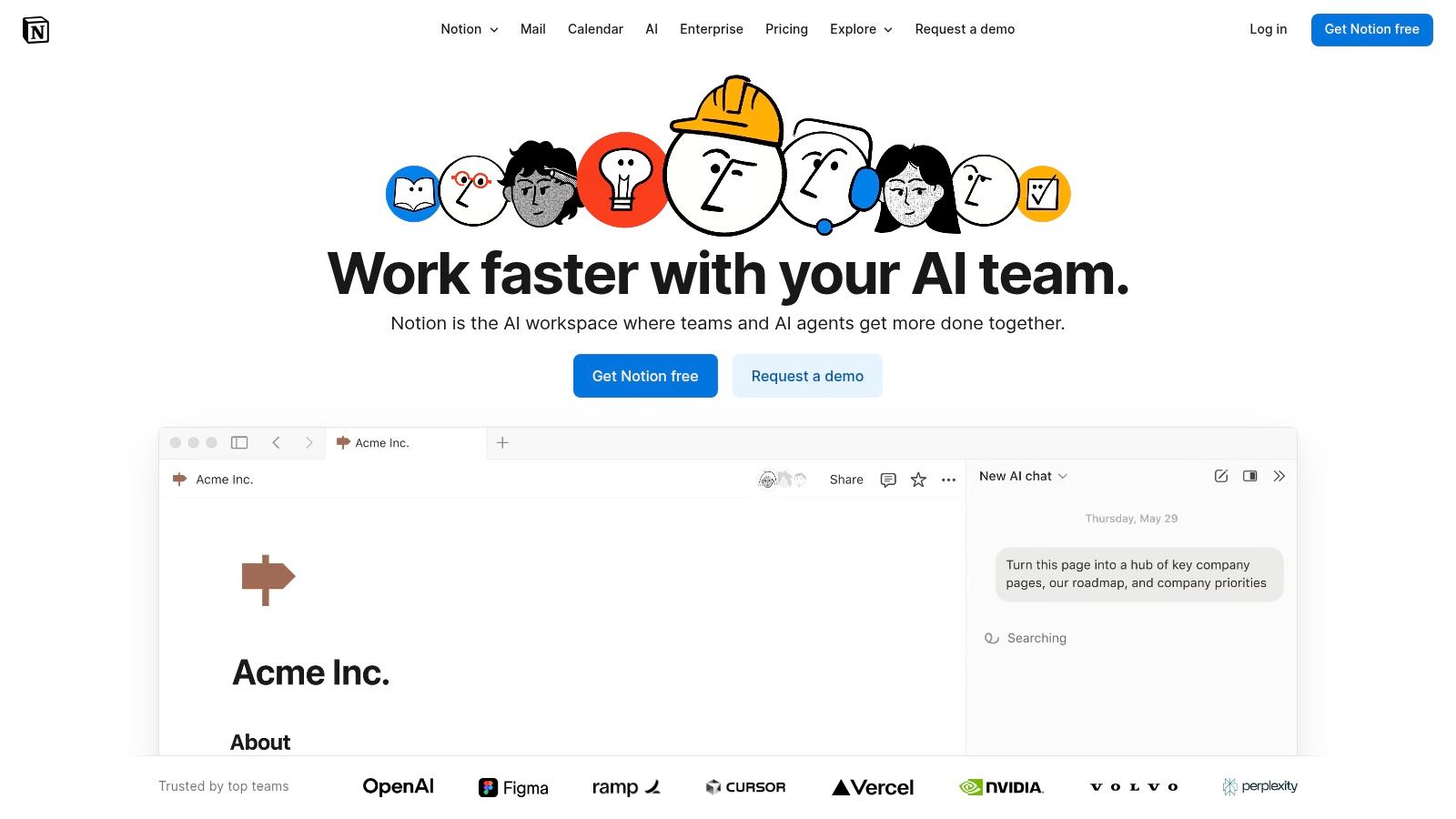
Notion AI acts as an embedded assistant that accelerates document creation and synthesis. It can draft initial PRD outlines, summarize lengthy user interview transcripts, or generate action items from meeting notes. This AI integration is particularly useful for reducing the "blank page" problem, enabling product managers to quickly structure their thoughts and documentation, which frees up time for more strategic work.
Core Features & Use Cases
- AI-Powered Drafting and Research: Use the AI agent to generate first drafts of product specs, user stories, or competitive analysis tables based on simple prompts.
- Intelligent Summarization: Instantly condense long research documents or meeting transcripts into key takeaways and action items, speeding up stakeholder communication.
- Flexible Databases: Create and manage backlogs, feature lists, and roadmaps with customizable properties, views, and templates tailored to your team's workflow.
Pricing and Access
Notion offers several plans, including a generous free tier for individuals. However, unlimited access to the core Notion AI features requires a paid add-on or upgrading to the Business or Enterprise plans. It's crucial to check the latest pricing, as AI access is often bundled differently across tiers.
- Pros: Highly versatile for all PM documentation, rapid AI feature development, easy setup for cross-functional collaboration.
- Cons: Full AI access requires a paid plan; advanced governance features are locked to the Enterprise tier.
Website: https://www.notion.so
6. Airtable (with Airtable AI)
Airtable is a powerful, flexible platform that blends the simplicity of a spreadsheet with the complexity of a database, making it ideal for product operations, roadmaps, and intake forms. With the introduction of Airtable AI, it transforms into one of the most versatile AI tools for product managers by embedding intelligent automation directly into their custom-built workflows, from managing feedback to tracking feature releases.
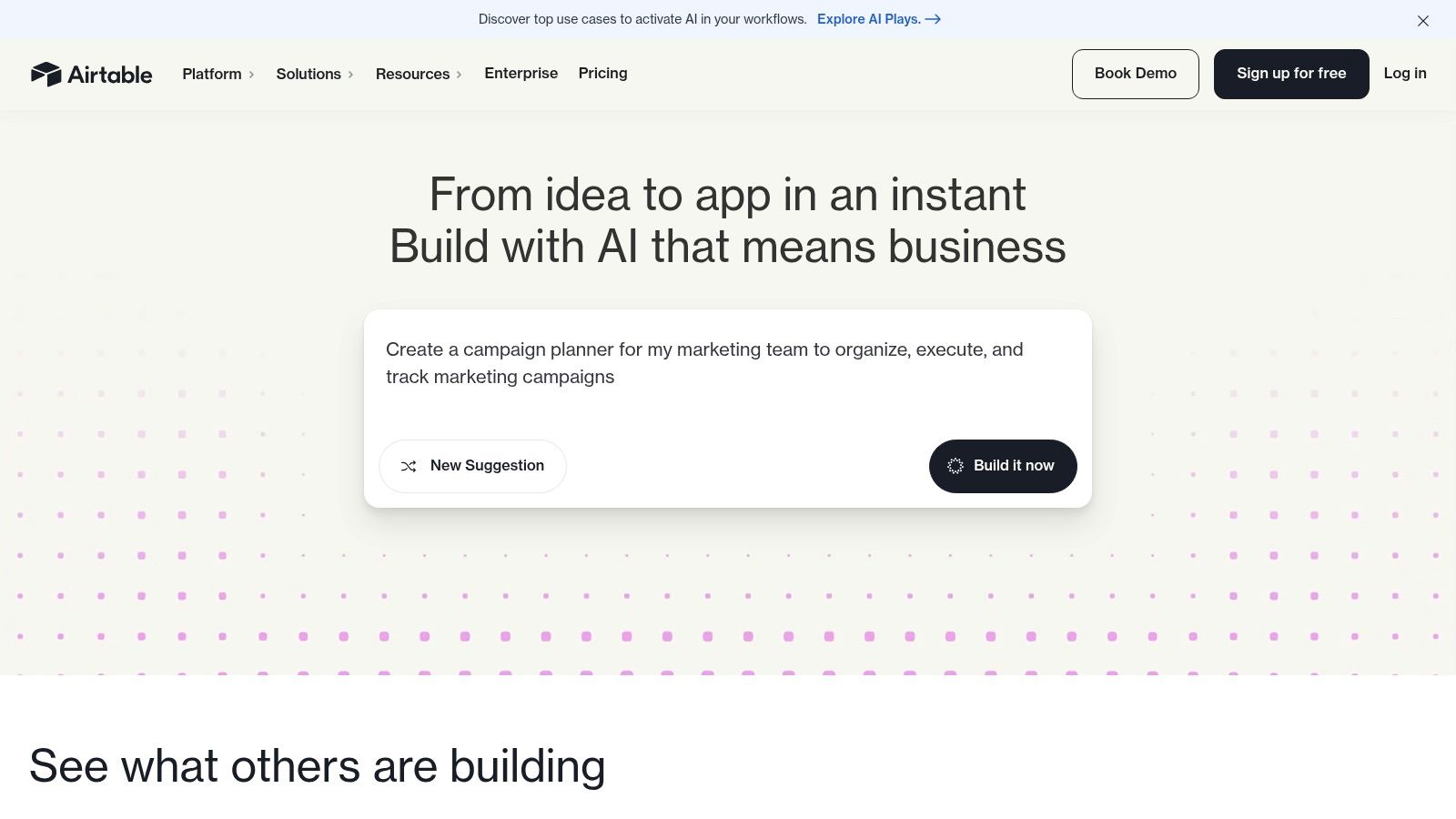
The platform’s AI features allow PMs to generate, summarize, and route product data with incredible efficiency. For example, you can automatically categorize incoming user feedback, draft summaries of project updates for stakeholders, or even generate initial marketing copy for a new feature directly within your product launch base. The ability to build custom AI automations tailored to a team's specific process is its key differentiator, providing immense operational leverage. Learn more about how AI can streamline product management workflows.
Core Features & Use Cases
- AI-Powered Fields: Automate content generation, summarization, and translation directly within your Airtable records, perfect for standardizing data entry or analyzing qualitative feedback.
- Customizable Interfaces & Forms: Create tailored views for stakeholders or intake forms for new feature requests, keeping everyone aligned without granting full database access.
- Robust Automations & Integrations: Connect Airtable AI with other tools like Slack or Jira to build end-to-end automated workflows, such as routing urgent bug reports to the right engineering channel.
Pricing and Access
Airtable offers several pricing tiers, including a free plan. Access to Airtable AI is included in the paid "Team" and "Business" plans, which provide a set number of AI credits per user. Admins can monitor and manage credit usage to control costs effectively.
- Pros: Excellent for operationalizing PM workflows, scales well from small teams to enterprise, includes AI credits for usage management.
- Cons: AI usage is credit-based and needs monitoring; complex schema design can be a challenge.
Website: https://airtable.com
7. ClickUp (with ClickUp Brain)
ClickUp has evolved from a powerful project management tool into a comprehensive work platform, and its "ClickUp Brain" AI layer solidifies its position among the top AI tools for product managers. It aims to be the single source of truth where tasks, documents, and goals converge. The AI is woven directly into these existing workflows, helping PMs streamline everything from initial ideation to sprint summaries.
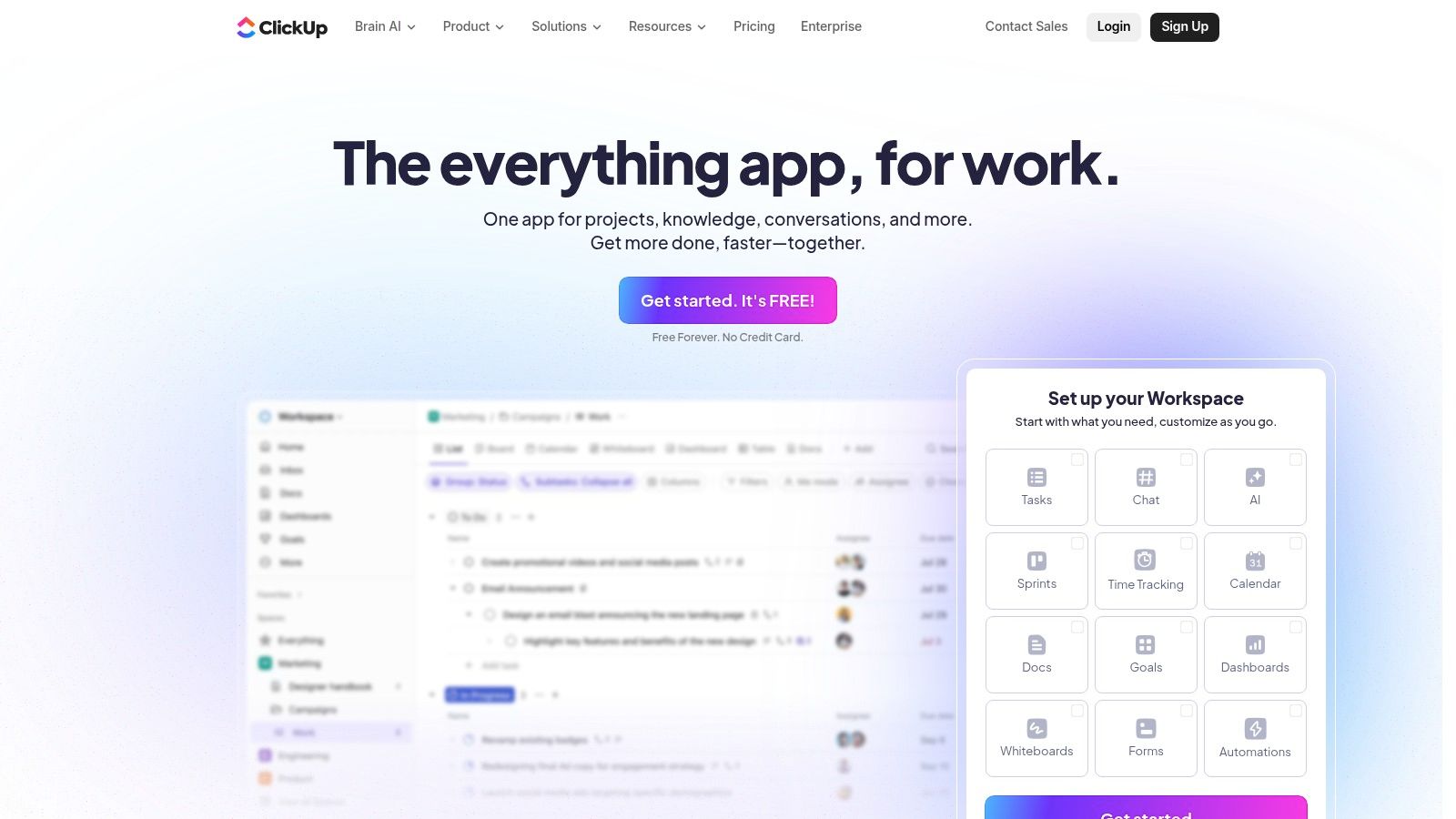
ClickUp Brain acts as a versatile assistant within your workspace. It can draft entire Product Requirements Documents (PRDs) from a simple prompt, generate status updates based on task progress, and summarize lengthy comment threads to quickly catch up on discussions. Its standout feature is the connected knowledge base, allowing you to ask questions and get answers sourced directly from your own tasks and documents. For those leveraging ClickUp, further details on how to connect various apps and AI meeting tools can be found in ClickUp's comprehensive integrations guide, including AI meeting tools.
Core Features & Use Cases
- AI Knowledge Manager & Q&A: Ask questions about projects, tasks, or documents and get instant, context-aware answers from your entire workspace.
- Automated Content Generation: Create first drafts of PRDs, user stories, sprint notes, and status updates directly within tasks or docs.
- Unified Workspace: The AI operates across tasks, docs, whiteboards, and goals, consolidating the need for multiple separate tools.
Pricing and Access
ClickUp offers a free plan with limited features. ClickUp Brain is available as a paid add-on for all paid plans (Unlimited, Business, and Enterprise), operating on a credit-based system. This allows teams to purchase the amount of AI usage they anticipate needing.
- Pros: Consolidates many PM workflows into one platform, competitive pricing for its broad feature set, rapidly improving AI capabilities.
- Cons: The user interface can feel busy until standardized for your team; managing AI credits adds a layer of administrative overhead.
Website: https://clickup.com
8. Asana (with Asana Intelligence and AI Studio)
Asana is a leading project management platform that has evolved into a powerful tool for strategic planning and execution, especially for larger organizations. Its Asana Intelligence features are integrated directly into core workflows, offering smart summaries, AI-generated status updates, and goal setting assistance. This makes it one of the more enterprise-ready AI tools for product managers focused on portfolio management and cross-functional visibility.
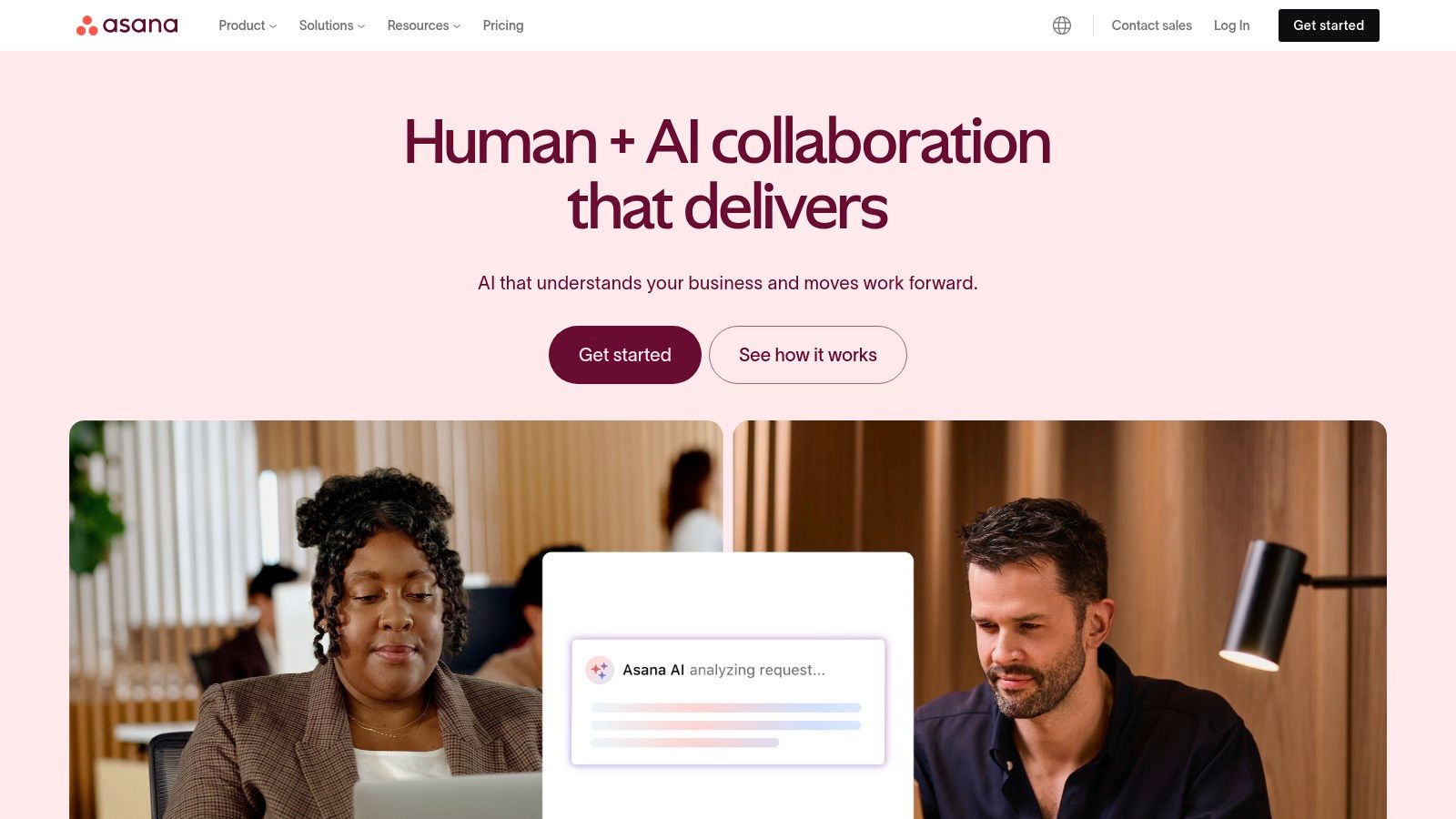
The platform's AI excels at simplifying complex projects and providing high-level summaries for executive stakeholders. Product managers can use it to draft project briefs, identify potential risks in a plan, and automate routine updates. The addition of AI Studio allows teams to build custom, cross-organizational AI workflows, connecting different data points to automate more complex processes without requiring deep technical knowledge.
Core Features & Use Cases
- AI-Powered Project Summaries: Instantly generate concise summaries of long task threads and project progress, perfect for quick status checks and stakeholder reporting.
- AI Studio for Custom Workflows: Design and implement intelligent rules and automations that connect various parts of the organization, from product roadmaps to marketing launches.
- Goal & Portfolio Management: Use AI to help draft strategic goals (OKRs) and get insights into portfolio health, ensuring development work aligns with business objectives.
Pricing and Access
Asana Intelligence features are available on Starter, Advanced, Enterprise, and Enterprise+ plans. AI Studio is part of the Enterprise+ tier and may involve additional credits for usage, catering to large-scale custom automation needs.
- Pros: Strong executive reporting and visibility, mature and easily adopted platform, deep enterprise-grade security controls.
- Cons: Advanced portfolio management and AI features are on higher-cost tiers; AI Studio usage can incur extra costs.
Website: https://asana.com
9. Miro (with Miro AI)
Miro is a collaborative digital whiteboard platform already essential for many product teams' discovery workshops and ideation sessions. With the addition of Miro AI, it transforms from a static canvas into a dynamic assistant, making it one of the most versatile AI tools for product managers focused on the early stages of the product lifecycle, such as research synthesis and collaborative brainstorming.
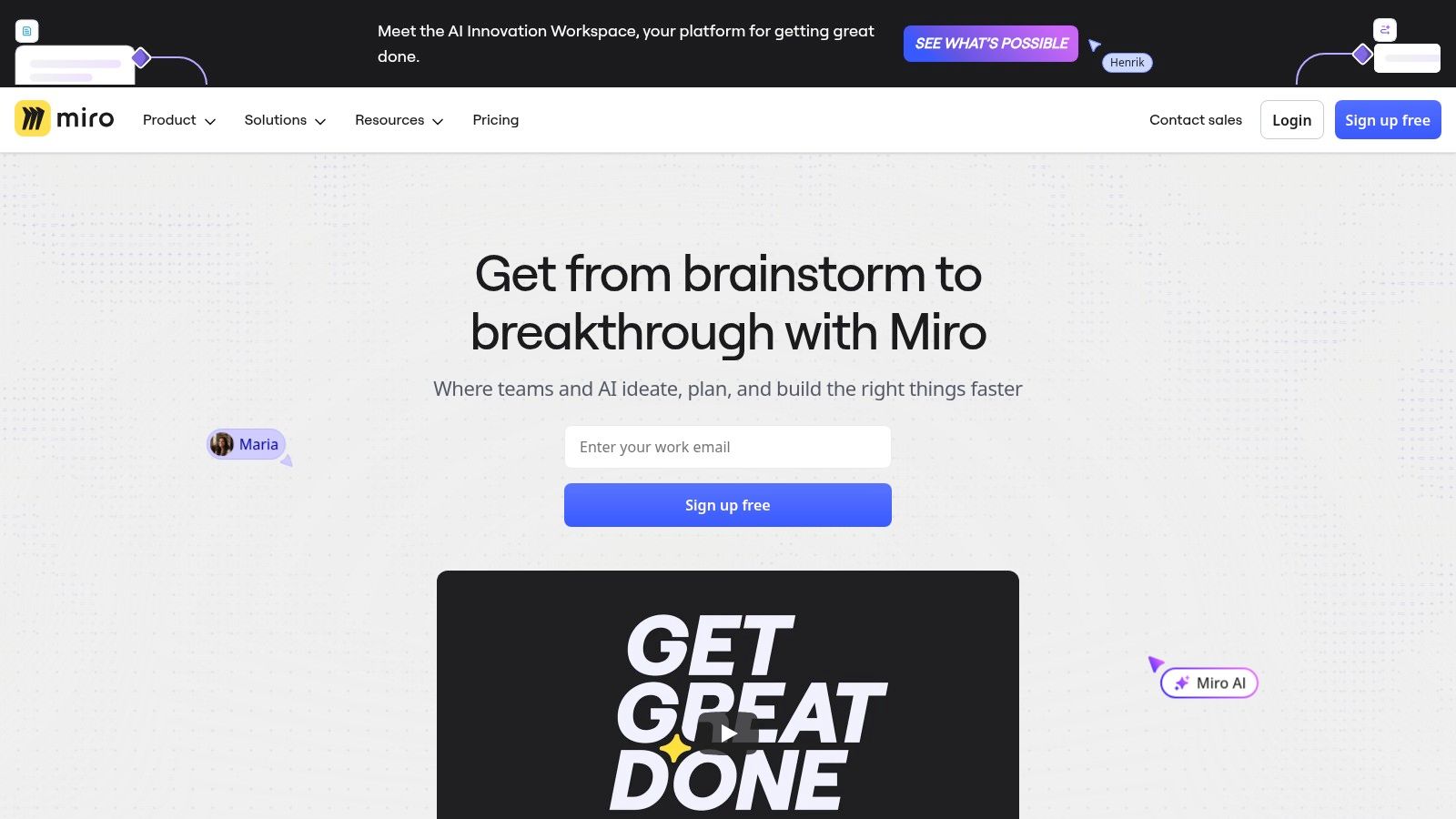
The AI features are built directly into the whiteboard experience, designed to accelerate manual tasks like organizing sticky notes or generating ideas. For example, after a customer interview synthesis session, Miro AI can automatically cluster digital sticky notes by theme, summarize key insights, and even draft initial user stories. This turns messy, raw data into structured, actionable items in seconds, facilitating a smoother transition from discovery to planning.
Core Features & Use Cases
- AI-Powered Clustering & Summarization: Instantly group and summarize vast numbers of digital sticky notes from research or brainstorming sessions, identifying key themes and pain points.
- Idea & Content Generation: Generate user stories, mind maps, or questions for user interviews based on a simple prompt, overcoming creative blocks and kickstarting workshops.
- Diagram and Wireframe Generation: Use AI to create sequence diagrams, user flowcharts, or basic wireframes from text descriptions, rapidly visualizing concepts for team alignment.
Pricing and Access
Miro AI operates on a credit-based system, with credits allocated per member based on their subscription plan. Free plans receive a small initial allotment, while paid plans (Starter, Business) get a more generous and often renewing supply. It is crucial to check your plan's details, as heavy AI usage might exhaust credits on lower-tier plans.
- Pros: Excellent for collaborative discovery and ideation, strong integration into existing PM workflows, extensive template library.
- Cons: AI credits can be limiting on some plans; most effective when used with established templates or processes.
Website: https://miro.com
10. ProductPlan
ProductPlan is a purpose-built roadmapping platform that excels at helping product teams visualize and communicate their strategy. While traditionally focused on roadmap creation, its recent AI additions make it a noteworthy contender among AI tools for product managers. The platform is designed for clarity and ease of use, allowing PMs to build and share strategic plans without the complexity of a full-suite product management system.
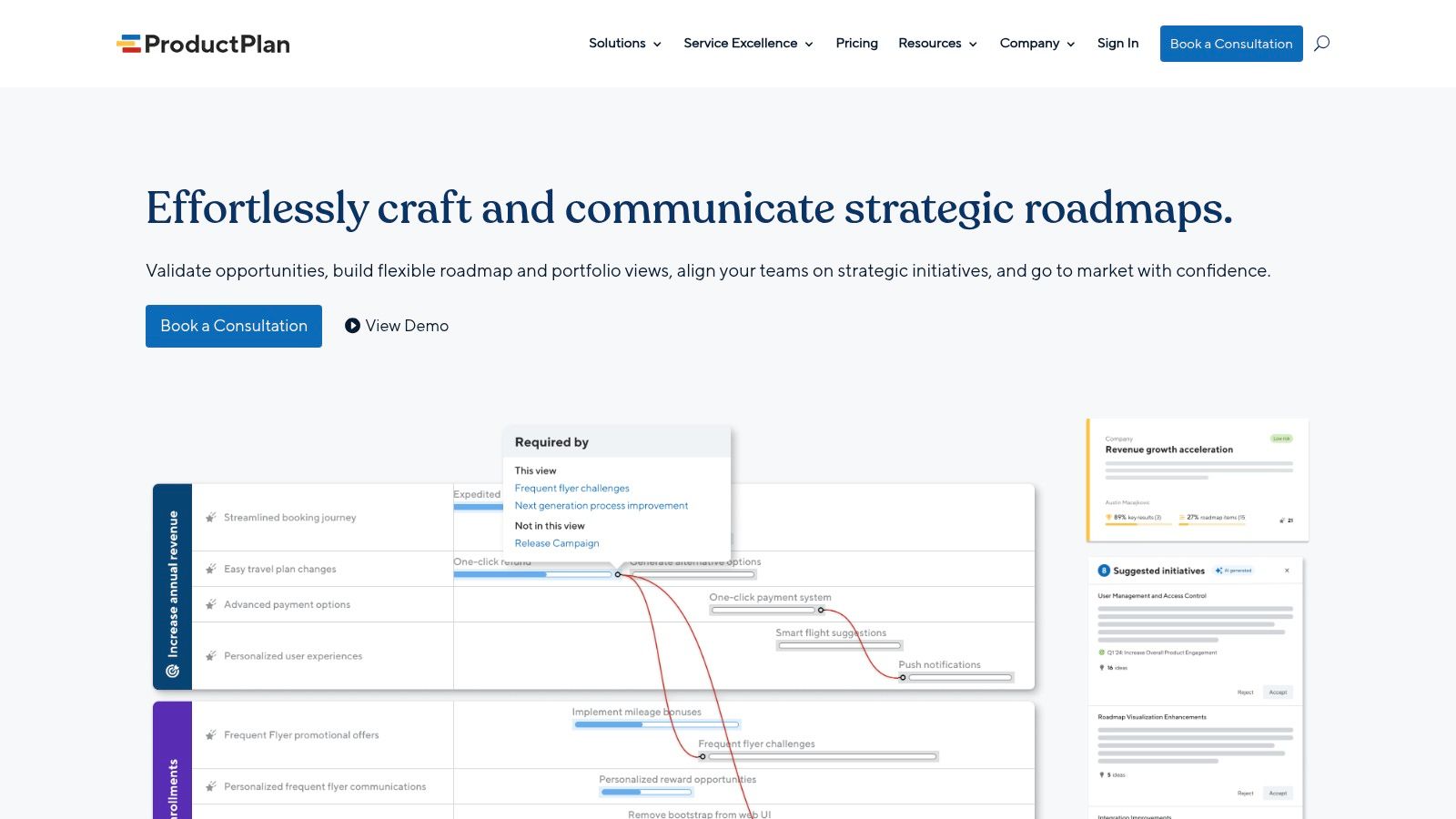
The AI capabilities in ProductPlan are focused on accelerating the strategic planning process. Its AI can suggest new initiatives based on your existing roadmap goals and generate concise, executive-level summaries of complex roadmaps. This helps PMs quickly articulate their plans to stakeholders and ensures alignment across the organization, transforming a static document into a dynamic, intelligent guide for product development.
Core Features & Use Cases
- AI-Suggested Initiatives: Get intelligent suggestions for new features or projects based on your strategic goals, helping to overcome creative blocks and identify new opportunities.
- AI Roadmap Summaries: Instantly generate clear, concise summaries of your entire roadmap, perfect for stakeholder presentations, executive updates, and team communications.
- Portfolio & Dependency Visualization: Its core strength remains its powerful and clean roadmapping interface, which clearly visualizes dependencies and portfolio-level views for large organizations.
Pricing and Access
ProductPlan's pricing is primarily available through direct consultation with their sales team. They offer various tiers tailored to different business sizes, but you will need to request a quote to get specific details. The unlimited viewer access is a key selling point, simplifying stakeholder collaboration without extra per-seat costs.
- Pros: Simple, clean roadmapping focus; unlimited viewer access simplifies sharing; scales well at the enterprise level.
- Cons: Pricing only available via consultation; limited scope compared to full PM suites.
Website: https://www.productplan.com
11. G2 – Product Management Software Category
While not an AI tool itself, G2's Product Management Software category is an indispensable research hub for comparing and discovering the best AI tools for product managers. It serves as a comprehensive marketplace where you can filter, compare, and read verified user reviews for dozens of platforms. For a PM tasked with selecting a new tool, this is the starting point for creating a shortlist based on real-world feedback and satisfaction scores.
The platform allows you to drill down into specific features, including AI capabilities, to see how different tools stack up. By leveraging its comparison grids and user-generated pros and cons, you can quickly identify which tools align with your team’s specific needs for things like AI-driven feedback analysis or automated roadmap generation. This meta-level resource saves significant time in the vendor evaluation process.
Core Features & Use Cases
- Software Comparison Grids: Directly compare up to four product management tools side-by-side on features, pricing, and user satisfaction ratings to accelerate decision-making.
- Verified User Reviews: Access thousands of in-depth reviews from actual product managers, offering candid insights into a tool's strengths and weaknesses.
- AI Feature Filtering: Use the platform to identify and research which PM platforms have integrated specific AI functionalities, helping you find a tool fit for your workflow.
Pricing and Access
G2 is completely free to use for browsing, comparing software, and reading reviews. Users can create a free account to save comparisons and follow specific software categories or vendors. Vendors pay G2 for enhanced profiles and marketing opportunities, but the core research functionality remains accessible to all users without cost.
- Pros: Excellent for initial research and vendor shortlisting, provides social proof via user reviews, free to access.
- Cons: Review quality can be inconsistent; the sheer number of options can sometimes be overwhelming without clear criteria.
Website: https://www.g2.com/categories/product-management-software
12. Product Hunt – AI and Product Management Discoverability
Product Hunt isn't a single tool but a critical discovery platform where tomorrow's leading AI solutions are launched daily. For product managers, it’s an essential resource for finding niche and innovative AI tools for product managers before they become mainstream. It excels at showcasing emerging tools for feedback analysis, roadmapping, and user story generation, often straight from the makers themselves.
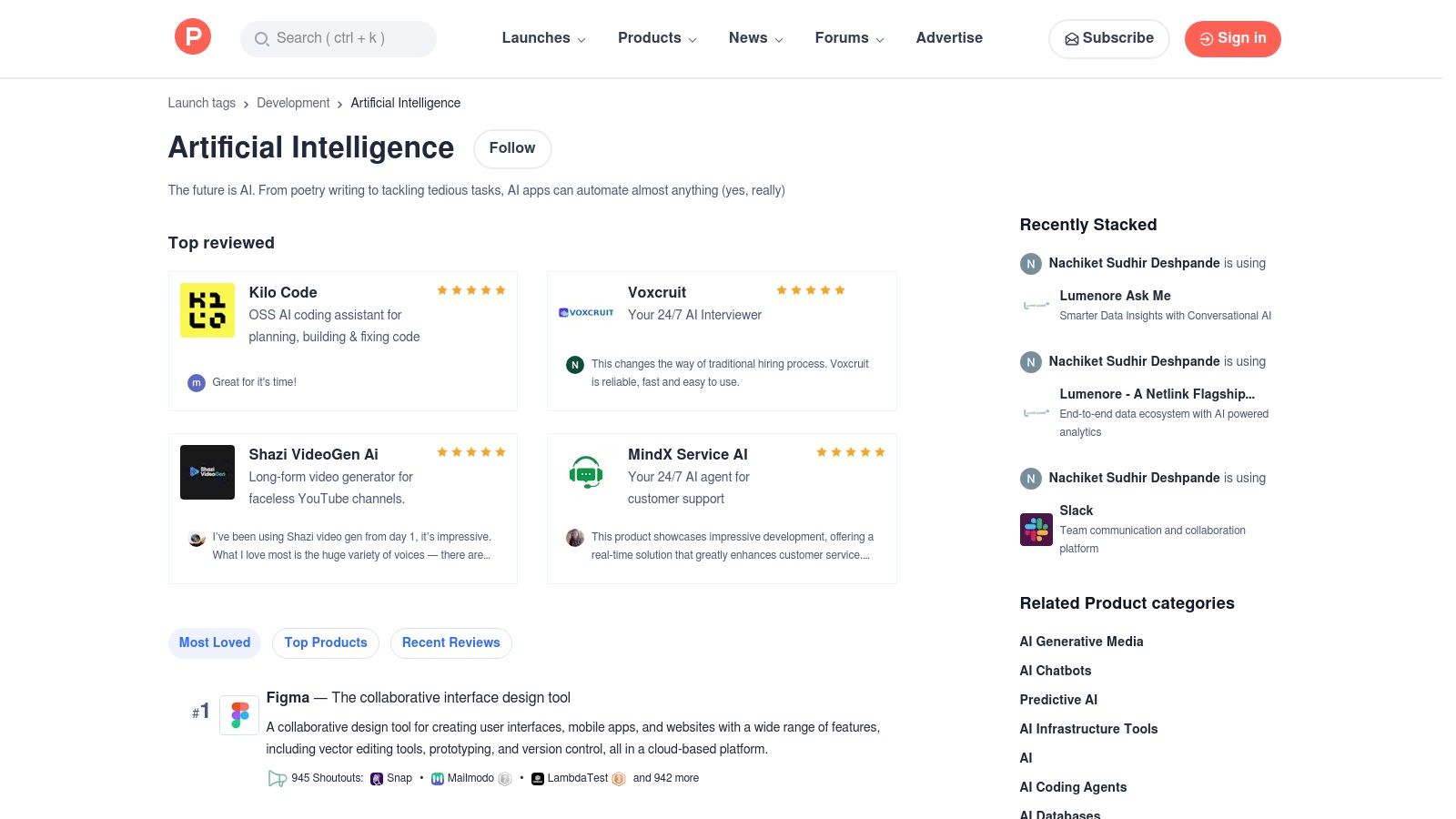
The platform’s strength lies in its community-driven curation and transparent discussions. You can see real-time feedback from early adopters, ask founders direct questions, and gauge a tool's momentum. This makes it an invaluable source for PMs looking to stay ahead of the curve and find specific AI utilities that solve a particular problem in their workflow, from creating personas to analyzing support tickets.
Core Features & Use Cases
- AI Topic Feeds: Filter daily launches to see only new products tagged with "Artificial Intelligence" to stay updated on the latest PM-relevant tools.
- Community Reviews & Q&A: Leverage community feedback and direct conversations with founders to vet a tool’s practical value and use case fit.
- Early Access & Niche Tools: Discover unique AI utilities for tasks like generating PRDs or summarizing user interviews that aren’t available on larger marketplaces.
Pricing and Access
Product Hunt is completely free to browse and explore. Pricing for the tools discovered on the platform varies by vendor, but many offer special launch-day deals or extended free trials for the Product Hunt community.
- Pros: Access to cutting-edge AI tools, authentic community feedback, free to browse.
- Cons: Product quality and security vary; requires careful vetting before adoption.
Website: https://www.producthunt.com/topics/artificial-intelligence
AI Tools for Product Managers: Feature & Capability Overview
| Product | Core Features/Characteristics | User Experience/Quality ★ | Value Proposition 💰 | Target Audience 👥 | Unique Selling Points ✨ |
|---|---|---|---|---|---|
| 🏆 SigOS | AI-driven behavioral analysis; real-time revenue impact scoring | ★★★★★ 87% correlation accuracy | 💰 Saves millions; data-driven prioritization | 👥 SaaS PMs, Growth, CS teams | ✨ Real-time alerts; secure encryption; seamless ticketing |
| Productboard | AI specs, feedback summaries, roadmap management | ★★★★ | 💰 Scales from free to enterprise | 👥 Product managers | ✨ PM-first workflow; deep feedback focus |
| Jira Product Discovery | AI brainstorming, idea scoring, Jira integration | ★★★★ | 💰 Premium plan for AI features | 👥 Jira users, product teams | ✨ Smooth discovery-to-delivery workflow |
| Aha! Roadmaps | Strategy-to-delivery roadmaps, AI assistant | ★★★★ | 💰 Higher price point | 👥 Product orgs, managers | ✨ Modular add-ons; governance focus |
| Notion (with Notion AI) | AI drafting, research, flexible docs | ★★★★ | 💰 AI on Business+ plans | 👥 Cross-functional teams | ✨ Versatile PM documentation |
| Airtable (with Airtable AI) | AI fields, automations, stakeholder interfaces | ★★★★ | 💰 Credit-based AI usage | 👥 PM ops, product teams | ✨ Strong automations and integrations |
| ClickUp (with ClickUp Brain) | AI for PRDs, sprint notes, task/docs integration | ★★★★ | 💰 Competitive pricing + credits | 👥 Broad PM teams | ✨ Unified platform; connected AI search |
| Asana (with AI Studio) | AI planning, smart summaries, portfolio management | ★★★★ | 💰 Enterprise pricing | 👥 Enterprise PM, executives | ✨ AI Studio workflows; security controls |
| Miro (with Miro AI) | AI clustering, prototyping, templates for ideation | ★★★★ | 💰 AI credits per user | 👥 Collaboration & discovery teams | ✨ Strong workshop/ideation support |
| ProductPlan | AI roadmap suggestions, dependency visualization | ★★★ | 💰 Pricing on consultation | 👥 Roadmap-focused teams | ✨ Unlimited viewers; clean UI |
| G2 – PM Software Category | User reviews, comparison grids, leader rankings | ★★★★ | 💰 Free to use | 👥 PM tool researchers | ✨ Broad vendor coverage; quick comparison |
| Product Hunt – AI & PM | Daily AI tool launches, community reviews | ★★★ | 💰 Free browsing | 👥 Early adopters, innovators | ✨ Early access to niche AI tools |
Integrating AI Isn't Just an Upgrade—It's a New Way of Working
The journey through the landscape of AI tools for product managers reveals a fundamental shift in how we build, manage, and iterate on products. The tools we’ve explored, from comprehensive platforms like Productboard and Aha! to flexible powerhouses like Notion and Airtable, are not just about adding features. They represent a new paradigm where the product manager’s strategic intellect is augmented, not automated. The core takeaway is clear: the most significant value comes from using AI to enhance human capabilities, freeing you from manual synthesis to focus on what truly matters: strategy, customer empathy, and creative innovation.
The sheer variety of options underscores a critical point: there is no single "best" AI tool. The right choice is deeply personal to your team's specific pain points and existing workflows. A team drowning in unstructured customer feedback will find immense value in a tool like SigOS, which quantifies qualitative data to surface undeniable trends. In contrast, a team struggling with a chaotic discovery process might gravitate toward the structured frameworks within Jira Product Discovery. The goal is to move beyond a simple feature-for-feature comparison and ask a more strategic question: "Which tool will most seamlessly integrate into our workflow and solve our most pressing bottleneck?"
How to Choose and Implement Your AI Toolkit
Selecting the right solution requires a thoughtful approach. Before committing, consider the following steps to ensure you’re adopting a tool that truly empowers your team:
- Identify Your Core Challenge: Are you struggling with roadmap alignment, feedback analysis, documentation, or project tracking? Your primary problem should guide your initial search. For instance, if your team spends excessive hours updating technical guides, exploring specialized solutions like AI Documentation Agents can deliver a significant and immediate return on investment by automating a specific, time-consuming task.
- Evaluate Integration Depth: A powerful AI tool that doesn't connect with your existing stack (like Jira, Slack, or your CRM) will create more friction than it removes. Prioritize tools that offer deep, native integrations to create a unified source of truth.
- Start with a Pilot Program: Instead of a company-wide rollout, test a promising tool with a small, cross-functional team on a single project. This allows you to measure its real-world impact, gather honest feedback, and build a strong business case for broader adoption.
- Focus on the Workflow, Not Just the Tech: The ultimate measure of success is how the tool transforms your daily and weekly routines. Does it reduce meeting prep time? Does it provide insights that lead to better prioritization decisions? The focus should always be on the tangible improvement to your product management lifecycle.
The Future is an AI-Augmented Product Manager
The role of the product manager is evolving. The days of spending hours manually tagging customer tickets or wrestling with spreadsheets to spot a trend are numbered. The AI-powered PM is a strategist, a storyteller, and a visionary who leverages intelligent systems to build a deeper, more quantitative understanding of their users. This transition allows you to spend less time on the "what" and more time on the "why," engaging in high-impact activities like direct customer conversations, creative brainstorming sessions, and long-term strategic planning.
The question is no longer if you should adopt AI tools for product managers, but how you will integrate them to build better products and more effective teams.
Which part of your product workflow are you most excited to enhance with AI?
Ready to transform your qualitative feedback into a strategic asset? SigOS uses AI to analyze customer conversations, support tickets, and reviews, providing you with the quantitative data you need to build a truly customer-centric roadmap. Stop guessing and start knowing what your users really want with SigOS.
Keep Reading
More insights from our blog


